A visit of one night and two days to experience the history, nature, and cuisine of Masuda
Situated on the westernmost end of Shimane Prefecture, Masuda lies close to the border with Yamaguchi Prefecture. It does not have any big tourist attractions like Izumo Taisha Shrine, which carries visitors back to Japan’s ancient past, or Iwami Silver Mine, which is inscribed on the World Heritage register. Nevertheless, it is all the more charming for its hidden allures! Its designation by the Japan Heritage as a city offering experience of medieval Japan evidences its deep interest. At the same time, it has plenty of appealing spots that are still largely unknown, such as numerous cafes that are particular about the fruits and coffee they serve, and designer hotels with hot-spring spas.
Here’s a special guide to the city of Masuda, Shimane, where you are bound to find a place just to your liking!
Day 1
The city of Masuda is “just right” for both tourism and residence. The streets in the vicinity of Masuda Station are lined with hotels, restaurants, and bars. A drive of only about 10 minutes from the station provides access to spots offering recreation by the sea, trekking in mountainous areas, and river activity. Masuda’s location is also highly convenient for travel; it lies only about 10 minutes away by car from the Hagi-Iwami Airport, where there are regular flights to and from Tokyo International Airport at Haneda.
In addition, Masuda boasts the biggest area of all cities in Shimane Prefecture, and grows Yuzu, Japanese horseradish, and other crops, thanks to its climate and nature.

Masuda therefore has a variety of appealing features. Due to the Tsushima Current flowing off its coast in the Sea of Japan, it is known for having one of the more mild climates in Shimane. An extensive cultivation of fruits is therefore another one of its characteristics.
To get our fill of Masuda’s gastronomic delights, we first paid a visit to Cafe Moritani, in front of Masuda Station.

Formerly a station-front fruit shop that had long been favored even by local customers, this establishment reopened in a beautiful white-walled building in December 2020, transformed into a cafe whose urbane atmosphere puts its customers into a comfortable and pleasant mood.
It serves delectable fruit sandwiches and sweets made with a rich assortment of fruits in season, mainly from orchards in Masuda.
It also sells gift-packaged fruits and fresh cake. When we visited, there were packages containing freshly picked strawberries and white grapes.

The cafe also sells local crafts, alcoholic beverages, and other items that can be purchased as souvenirs, just like that.
It’s nice to be able to buy a little something at a store located conveniently near the railway station.


The parfaits made with plenty of fruits in season are a popular item on the menu. The cafe always prepares seven different types.
I was told that the fruit parfait containing seven kinds of fruit was a favorite, but chose the strawberry parfait on that day.
The cream was lightly sugared and only slightly sweet. The ice cream was made with Jersey milk from Yamabuki Green Farm, which is in the neighboring town of Yoshika-cho. In spite of its rich flavor and body, it leaves a clean taste in the mouth, and is perfect for highlighting the chunks of fruit as the centerpieces.
At the very bottom of the glass was some jelly. The parfait was made so that the fruit is magnificently set off by the other components, which played supporting roles.
The joy of a mouthful of fresh fruit!
It is full of vitamins and must also be good for the skin.
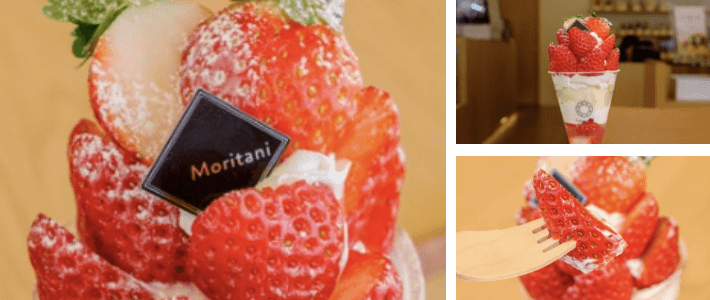

The cafe also distributes photos of the fruits available at any given time on its Instagram account (https://www.instagram.com/moritani55/).
Please access it to see some mouth-watering fruit!
After savoring the delicious parfait, I headed to Kaneyoshiya, a liquor store.
The store handles Japanese sake and shochu liquor from all parts of Japan, and wines from around the world.
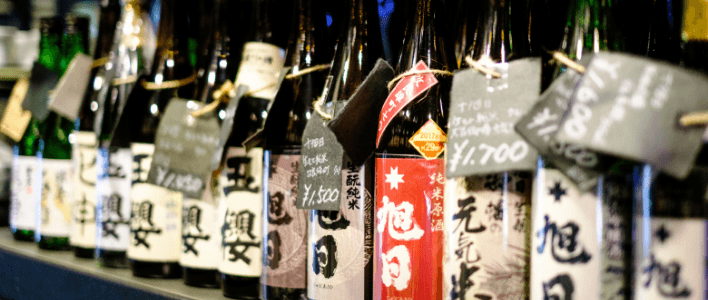
A sake brewery was on the itinerary for this visit, and I was told to get the advice of an expert in handling sake if I was going to be sipping some. I therefore stopped by Kaneyoshiya to ask get some information from Mr. Fukuhara, its proprietor, while actually sampling some sake.
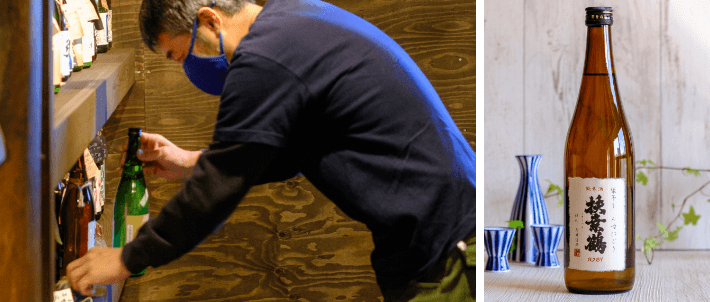
Mr. Fukuhara told me that, although orthodox sake used to predominate in Shimane in the old days, a variety of types with a good balance had recently become available even there in both the sweet and dry categories. In his eyes, this was part of the attraction of local sake.
Here is the brand he recommended for me.
Fusozuru, from Kuwabara sake brewry.
Kuwabara sake brewry is a Masuda sake brewer and seller that will soon celebrate the 120th anniversary of its founding. It uses underflow water from the limpid currents of the Takatsu River. Even for Fusozuru, its main brand, it performs the time-consuming fukuro-zuri process, in which unrefined sake goes into the vat a drop at a time from a bag suspended over it. The sake had a fresh taste, and I enjoyed sipping it at room temperature.
Mr. Fukuhara also gave me tips on when sake is best enjoyed, and how (warmed, at room temperature, or chilled). Regarding sake that is not pasteurized, he additionally gave me information on things such as when to drink it, based on maturation in the bottle.
He also told me some entertaining stories revolving around sake. I would encourage visitors to speak up and ask him anything they like.


Spots of historical interest are scattered here and there, and seem to have blended into the neighborhood.
One of the particularly noteworthy things about Masuda is that it has not one but two gardens designed by the eminent artist-monk Sesshu.
They differ from each other, and are both well worth seeing.
One is the garden in Manpuku-ji Temple.

In the mythology of ancient Indian Buddhism, Sumeru was a mountain at the center of the world.
Modeled on the vision of Mount Sumeru, this garden expresses the Buddhist world view with rock arrangements and formations.
Spending a leisurely interval in the garden while viewing and feeling it with your heart is bound to soothe your soul.

With an advance reservation, you can also have a cup of green tea.
Conversing about the esthetics of the garden while nibbling on Japanese confections matching the season would likewise be a nice thing to do here.

The other garden designed by Sesshu is in Iko-ji Temple.
In it, a rock shaped like a turtle is in a pond shaped like a crane. The temple is visited by many people toting cameras when its big weeping cherry tree is in bloom, for it is a breathtaking sight.


The garden was a deeply impressive one that made me forget my everyday fatigue.
Please don’t fail to see the temple’s main gate, which reportedly stood at the front entrance of Nanao Castle before it was moved here.
After such a pleasant morning, it was time for lunch by the sea.
Masuda has many individualistic restaurants.
The next one I would like to introduce is Cafe & Dining Kaki no Ki. It boasts a superb location.


Customers can sit either inside, where they have a panoramic view of the Sea of Japan, or on a recently added terrace deck featuring wide-open space. The lunch menu consists of omelettes with rice filling, Salisbury steak, and other dishes of Western cuisine.
My entree was served with a colorful fresh salad and deep-fried shrimp.

The menu had so many items that I didn’t know which to choose.
On that day, they were also serving deep-fried oysters and stone-roasted omelettes with rice filling.
Every time dishes were brought to a table, there were cries of “wow, looks delicious!”

The restaurant has a parking lot that makes it convenient for a stop while taking a drive along the coast.

Another place I would recommend is “Pain & Confiture monukka”.
It turned grapes, one of the fruits grown in Masuda, into products.
The store is run by Tanaka Vineyard, and also sells grapes at the adjacent building in harvesting season. The vineyard has been operating for three generations beginning about 60 years ago, and grows various types of grapes, based on a small-lot, high-diversity production setup.

True to its name, monukka sells mainly bread and jam, but beginning seven years ago, it took up the challenge of making wine and other items.
As soon as you enter the store, you can smell the lovely aroma of bread.
The store began selling bread about 15 years ago. It bakes batches several times a day. I was told that the biggest assortment comes out of the oven around 11 in the morning.
Especially popular is the bread named “Monukka”, after the store. It is a heart-shaped loaf containing walnuts, cream cheese, and raisins.
It has a firm texture, and its flavor deepens the more it is chewed. According to the staff, “Monukka” is the name of a rare species of grape.

Seto Giants and Yuzu Lodeve. The crumb (white part) is soft and chewy. Locally grown Yuzu are kneaded into this bread, which the staff recommends.

The confiture contained little bits of grapes. It had a fruity flavor and light texture.
The grapes are grown with little use of agricultural chemicals, and can be eaten with peace of mind just as they are.

Choose a bread of your liking and take something delicious from Masuda back with you.
The store is a great place to buy a little gift.
After satisfying such physical wants, I headed for the Takatsu River for some communion with Masuda’s nature.
The Takatsu River has been repeatedly found to be the clearest river in Japan in water quality surveys conducted by the Ministry of Land, Infrastructure, Transport and Tourism. It is also famous for being the only Class A River in Japan that does not have a single dam on its main channel or its tributaries. It has an established reputation for transparency of the water.
In addition, thanks to its outstanding clarity, the river is home to sweetfish, mitten crab, and other creatures that are tasty Masuda specialties.
The best activity for full enjoyment of the charms offered by the Takatsu River is kayaking.
I too immediately tried my hand at it.

Would you believe it? I started paddling straight away, without any instructions about how to hold and use the paddle.
But to commune with nature while feeling the flow of the river doesn’t require any reasoning.
The water was so transparent that I could clearly see the pebbles on the bottom even in deep spots.

Along the Takatsu River are several renowned bridges. Going under some of these bridges gave me unusual views of them from the river. It was wonderful to go under not only the Iida Bridge, whose red structure looked striking against the blue sky, but also the Takatsuno Bridge, with its many arches.

After a while, I beached the kayak and took a break on the river bank. Having a cup of coffee and leisurely conversation on the river bank also makes for a relaxing interlude. Visitors can rent not only one-passenger kayaks but also two-passenger ones. Up to 30 people can experience the river by kayak at a single time.

I found it absolutely refreshing to listen to the gurgle of the water and song of birds, far from all the noise of everyday life.
It was a soul-soothing experience to see such a big sky and be enveloped in the great outdoors for the first time in a long time.

Having gotten a little exercise with the kayak, I had a delicious glass of beer at a craft beer brewery near the Takatsuno Bridge.

Takatsugawa River Beer – Takatsu Brewery opened in March 2021 on the site of what was once a Japanese-style restaurant on the frontal approach to Takatsu Kakinomoto Shrine. It offers beer made with local agricultural products.

The brewery sells many styles of beer, including White Ale, Pale Ale, Weizen, and Farmhouse. You can undoubtedly find a flavor you like there.
On this day, we clinked glasses by the Takatsu River. Drinking beer outside is exhilarating, don’t you agree?

After spending the day enjoying my trip to Masuda, I went to Mascos Hotel, a designer’s hotel located near the station.
Mascos hotel opened in 2019, and is equipped with a spa fed by its own hot springs. Each and every one of the interior design items had a sophisticated flair, and the hotel was comfortable.

The big bath was as pretty as a pool, and the changing rooms and other facilities were neat and clean.

I had dinner that evening at Mascos Bar & Dining, a restaurant inside the hotel.
I asked the waiter which menu item was a popular choice for dinner, and ordered that.

Mascos also has a full line of non-alcoholic cocktails looking this stylish.
Strawberry Mozzarella is an appetizer featuring Matsuda-grown strawberries. The strawberries are seasoned with boiled-down white balsamic sauce. The dish has a light taste.

Mascos Hamburg, a dish crowned with the hotel’s name, is a juicy Salisbury steak made with coarsely ground beef. It is a classic kind of meat dish whose simple seasoning highlights the flavor of the beef.
The Wagyu beef steak they served on that day was a tri tip. The French fries were garnished with homemade mayonnaise flavored with Yuzu.

Fritters made with conger eel taken off the coast of Shimane. The deep-fried batter was crisp, and the eel was tender.
Every dish was served in a generous portion, and made for a hearty meal.
Pasta with raw laver, mullet roe, and whitebait.
The mineral flavor and body of the roe multiply the savory taste in the mouth.

The dishes holding the foods served are also originals. They were made in collaboration with kilns, such as the Miyauchi Kiln for Iwami ware and the Oya Kiln for Hagi ware.
I must add that, like the Yukata Gown pajamas used in the hotel and the aprons worn by the staff, the ware is also available for sale.

With this, my first day in Masuda came to a close. I took it easy in the hotel that night and prepared for the itinerary on the next day.

◆Day 2
My second day started out with breakfast in Mascos Hotel.
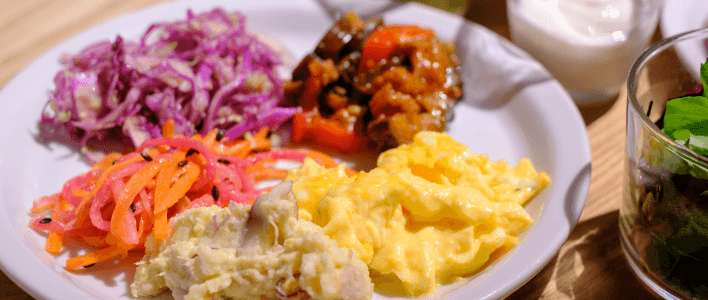
They served both Japanese- and Western-style breakfasts, with plenty of vegetables.
The menu included vegetable smoothies, yogurt, and other healthy items that would be welcomed by women.
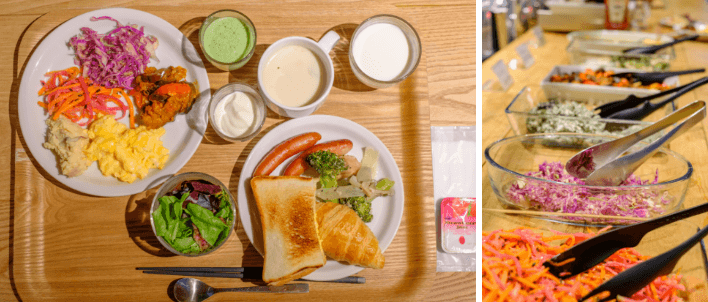
Recharging my batteries in the morning, I continued my travel in Masuda again this day.
My first destination was Grand Toit, a Masuda landmark.
This is the Shimane Arts Center, a multi-use facility dedicated to the arts and culture. It consists of the Iwami Art Museum and Iwami Arts Theater. It is affectionately called “Grand Toit” (French for “big roof”) by the locals.
First and foremost, the outstanding architecture is incredible. The building’s reddish brown exterior comes from the use about 280,000 Sekishu tiles, which are special products of the Iwami area, and is bound to catch the eye of even those who knew nothing of the Center’s existence.

Designed by the architect Hiroshi Naito, the interior brings together diverse materials and reflects the hallmarks of his architecture with features such as successive staircases positioned at short intervals. The facility is floored with quince wood, whose distinctive reddish hue complements the color of the tile.

The courtyard surrounded by corridors is occupied by a shallow pool. In its waters, visitors can admire the reflections of wall tiles lit by the sun and the sky above.
Just gazing at the still surface of the pool has a calming effect on the mind.
If you come to Masuda, make sure not to miss this complex!

Leaving Grand Toit, which is well worth visiting, my next destination was Myogi-ji Temple.
Here, I experienced zazen meditation and making tofu.

I learned about the basics of zazen by listening to the explanation of the superior.
I asked him what it meant to quell your feelings and make your mind blank.
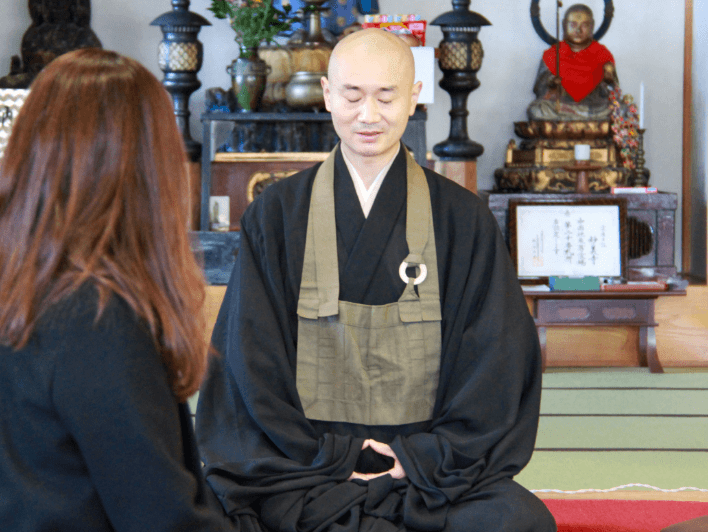
In zazen, you meditate by confronting yourself and not letting your mind wander.
If you consciously try not to think of anything, all sorts of things, on the contrary, end up getting on your mind. At any rate, I was told it was good not to think of anything. It is also important to let your body relax and avoid tensing up.
The tranquility of the main hall quiets the mind and helps to rid it of worldly thoughts, so you don’t think of anything.
To take the time (even just a few dozens of minutes) to meditate like this every day may be just what we need in this busy world of today.

At Myogi-ji Temple, I also tried my hand at making tofu.
Tofu is part of the vegetarian food eaten at temples. Myogi-ji offers firsthand experience of its preparation in a package with the meditation experience.

I made tofu with soy milk and Oki bittern used in the local Masago Tofu.
The tofu was finished after we waited for it to harden to a wobbly consistency while watching the temperature.
Because the tofu is made with rich soy milk, the sweetness of soybeans fills the mouth when you take a bite.
The soft and creamy tofu is delicious even eaten by itself.

The tofu is served with a medicinal herb sauce, Yuzu sauce, and plum sauce, all made with seasonal ingredients.
The set includes an o-nigiri rice ball made with brown rice that has been left to stand for a few days after cooking, and a bowl of miso soup. The meal was deeply satisfying.
Anyone can make mistake-free tofu that tastes great in spite of being so easy to prepare.
There’s no reason not to!

The last stop on my trip to savor Masuda was Keirando.
This, the Keiran Manju, is an iconic souvenir of Masuda.
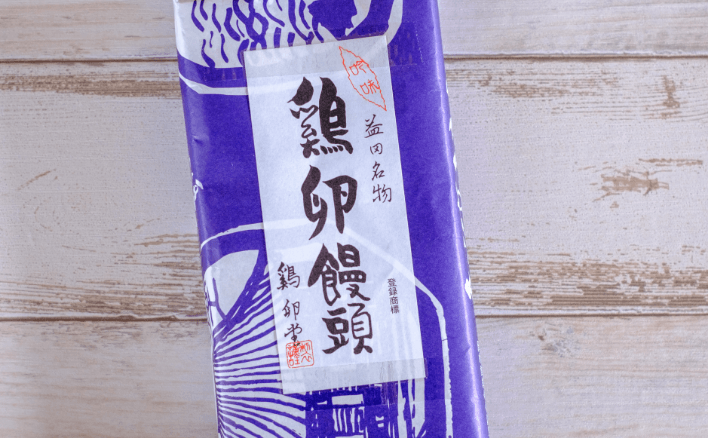
It is a cute little bun made by wrapping sweet white bean paste in fluffy sponge cake.
To my surprise, I was given a special tour of the plant.

Fresh out of the oven, the buns are crispy on the outside and almost overflowing with smooth white bean paste on the inside.
The tasty yellow cake is made with plenty of locally produced eggs. I was happy to discover that the buns had a subdued sweetness, which made me think I could eat many in one sitting.
The treat reportedly originated at a store selling Japanese confections in Kyoto.
The owner received the recipe from that store, and the buns are now renowned as one of Masuda’s specialties.
The cake, which has a crispy crust right after baking, is soft and fluffy in the buns packed for gift-giving.

At the airport, I found another souvenir item I would like to introduce.
Since 2016, they have been keeping bees and making Airport Honey at Hagi-Iwami Airport.
The honey taken from combs on the grounds of the airport is put into jars as is. On top of this, they make more than 10 types of processed honey products. While these have been mainly confections so far, the airport began selling Airport Mead in 2020. This is a type of wine made with honey.

Mead is made by fermenting honey. It is light and goes down easily. It tastes something like noble rot wine. It can be enjoyed in a wine glass, but is also delicious when chilled with ice cubes.
If you take it to a party, it’ll be a big hit. It is a souvenir that is unusual and will please everybody.
Airport Honey is a precious item that cannot be mass-produced. It is very popular and sells out every year. Therefore, if you see this new souvenir on your trip to Masuda, be sure you buy it!

Masuda is a city where you can commune with nature, relish the finest cuisine, and get reinvigorated by experiencing various activities.
There were also times when I came into casual contact with history as I traveled. The beautiful gardens and old temples made me feel refreshed.
When I look back on the trip, I steadily recall places that impressed me, one after another. A trip to Masuda has the kind of profound enjoyment that makes all the good things about it silently float up in the mind long afterward.
For this trip, I confined my itinerary to a quite compact area. Even in this area, however, there are still many popular stores and hidden sight-seeing spots that I didn’t make it to this time.
The deeply interesting Masuda may show you a different face every time you visit.

Ai Nishimura
Shimane Envoy (a Shimane Prefecture furusato goodwill ambassador)
An author on travel & cuisine, and a photographer
A popular blogger who has more than 26 million PVs
Born in the city of Izumo, Shimane Prefecture, now residing in Tokyo
Since 2007, Nishimura has been working as a freelance author. She has written pieces for clients including airline companies, major travel agencies, and leading beverage manufacturers. Her work has been serialized on SNS media and weekly magazines. Her specialty is essays on travel and delicious food.
Co-authored works
Shimane chiri, chimei, chizu no nazo (The mysteries of Shimane geography, place-names, and maps), (Jitsugyo no Nihon Sha, Ltd.
Watashi no machi ga Nippon-Ichi Jiten (My town is number one in Japan – A dictionary), PHP Institute, Inc.
Neko Neko Nihonshi de wakaru todofuken (Learning about prefectures from the anime “Meow Meow Japanese History”) (Jitsugyo no Nihon Sha, Ltd.)
